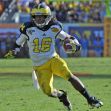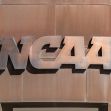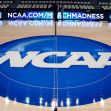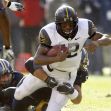The Supreme Court has just put a crack in the door that the NCAA had nailed shut to prevent college athletes from sharing in most of the massive profits generated by their athletic teams from ticket sales, alumni donations, television rights and other cash cows. How large that crack will eventually be is yet to be tested.
But for now, at least, players won’t have to buy their own computers, because “education-related benefits” will be permitted. Athletes will no longer be limited to receiving just “the full cost of attendance,” which means tuition, room and board a few incidentals. And in the future, depending on how wide that door opens, and how “education-related benefits” are defined by the National Collegiate Athletic Association (NCAA) and its members, student-athletes may one day be allowed to profit from putting their names on lucrative items such as shoes, energy drinks and other commercial goods.
The case began seven years ago when Shawne Alston, a football player from West Virginia, brought an anti-trust suit against the NCAA and five college sports conferences seeking unspecified damages based on the difference between actually attending college and an athletic scholarship that only covers tuition, fees, room, board and books.
In a June 21 opinion, Justice Neil Gorsuch, writing for a nearly unanimous court in an 8-1 opinion, affirmed the decision of the Ninth circuit that partially sided with college athletes in 2020, when it ruled that that NCAA limits on non-cash benefits for education-related expenses like computers, science equipment, study abroad programs, graduate school, musical instruments and other tangible items, were unlawful. The circuit court imposed a permanent injunction on rules that imposed these types of restrictions, while still allowing the NCAA to maintain rules limited to undergraduate scholarships and “other compensation related to athletic performance.”
The students were fine with the district court’s decision. The NCAA was not, and its appeal, according to Gorsuch, “seeks immunity from the normal operation of the antitrust laws.” Gorsuch concluded, “The national debate about amateurism in college sports is important. But our task as appellate judges is not to resolve it. Nor could we. Our task is simply to review the district court judgment through the appropriate lens of antitrust law. That review persuades us the district court acted within the law’s bounds.”
Gorsuch’s opinion only discussed the Sherman Act via a “fact-specific assessment of market power and market structure aimed at assessing the challenged restraint’s actual effect on completion.” He noted that “The NCAA accepts that its members collectively enjoy power in the market for student-athletes services, such that its restraints can and (and in fact do) harm competition.” Monopsony aptly describes the NCAA since it is defined as a market structure in which there is a single buyer.
Gorsuch discounted most of petitioner NCAA’s arguments by summing them up as a proposal for ”a sort of judicially ordained immunity from the terms of the Sherman Act” and disagreed with its contention that “we should overlook its restrictions because they happen to fall at the intersection of higher education, sports, and money.”
The court’s opinion began with a lengthy discussion of the Sherman Antitrust Act, which is supposed to allow market forces to “yield the best allocation” of the nation’s resources. Plaintiffs argued the NCAA and some of its members consistently violate the Act when they limit the amount and type of compensation allowed to student-athletes who sacrifice their time, energy and frequently their bodies for victory and the possibility of being noticed by a pro-team scout.
The district court agreed that limits on giving athletes just tuition, room and board “may be price-fixing agreements,” but it found them reasonable in light of the possibility the “professional-level cash payments…could blur the distinction between college sports and professional sports.”
Gorsuch reviewed the history of what would be called NCAA v. the Sherman Act if it were a single case. He recapped what he called “a complicated relationship with sports and money” that began in1852 when Harvard met Yale in a boat race sponsored by a railroad executive who paid participants with a lavish vacation and unlimited alcohol. But the real bonanza soon turned out to be football, and promising athletes were offered all sorts of intriguing bonuses, even if they had no intention of going to class. The solution, brokered by President Theodore Roosevelt, was the creation of the NCAA.
In 1906, the NCAA wrote a by-law that stated, “[n]o student shall represent a College or University in any intercollegiate game or contest who is paid or receives, directly or indirectly, any money, or financial concession.” It was frequently ignored. In 1929, a study by the Carnegie Foundation concluded, “College football was “not a student’s game”; it was an “organized commercial enterprise.” Congress held hearings and in 1948, the NCAA wrote a new code that permitted tuition payments and other incidental payments but also instituted a wide range of controversial enforcement powers.
While small changes were made, the NCAA grew to a massive organization with over 1,100 members, including all colleges from all the major Division I Conferences. Gorsuch describes it now as a “massive business” and gives one example of its current earnings, writing, “The NCAA’s current broadcast contract for the March Madness basketball tournament is worth $1.1 billion annually.” He also cited NCAA salaries, with the president currently earning $4 million per year and commissioners from the top conference “tak(ing) home between $ 2 and $5 million each year.
Gorsuch next turned to the applicability of the Sherman Act, which the district court had applied. “In short, the NCAA and its member schools have the “power to restrain student-athlete compensation in any way and at any time they wish, without any meaningful risk of diminishing their market dominance… The NCAA’s compensation limits “produce significant anticompetitive effects in the relevant market.”
The NCAA’s argument that its rules both increase consumer demand and help “maintain a competitive balance” was not persuasive. When those justifications were shot down, “The NCAA’s only remaining defense was that its rules preserve amateurism…,” and Gorsuch wrote that the court did not agree with that either.
Gorsuch’s conclusion states, “Some will think the district court did not go far enough…while some will see this as a poor substitute for fuller relief. At the same time, others will think the district court went too far by undervaluing the social benefits associated with amateur athletics.”
His prescient observation predicted the commentaries that followed. CNN, for example, said, “it could also benefit student-athletes by paving the way for more lucrative opportunities.” Steve Berman, co-counsel for the athletes who brought the case, told ABC News, "We're thrilled with the decision. It opens the door for further challenges to the NCAA's biased compensation practices. It knocks out the NCAA defense…and not only sustains our victory but makes it clear going forward that the NCAA rules can be challenged like any other business rule."
Comments like these make it likely that in the future, Justice Bret Kavanaugh’s concurring opinion may be tested. “The NCAA’s remaining compensation rules do not go far enough,” he said. "Nowhere else in America can businesses get away with agreeing not to pay their workers a fair market rate on the theory that their product is defined by not paying their workers a fair market rate. And under ordinary principles of antitrust law, it is not evident why college sports should be any different."






